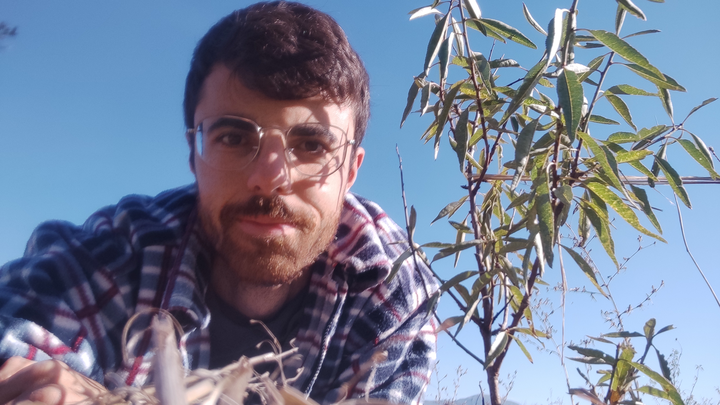
Save the almond trees, regenerate inland Abruzzo!
Donation protected

- ENGLISH BELOW -
Ricordo distese di fiori rosa e bianchi a primavera, nel mio paese natale, nel cuore montano dell'Abruzzo. Erano i mandorli che i nostri antenati avevano pazientemente seminato nel corso dei decenni e dei secoli, per dividere i confini dei terreni e per trarne un reddito in più dalla vendita dei loro piccoli frutti legnosi.
Oggi, con l'avvento dei trattori e l'abbandono delle siepi, quelle vallate profumate sono sempre più spoglie, i mandorli tronchi secchi contorti. L'incredibile diversità genetica data dalla semina diretta, che rende ogni pianta un esemplare unico, sta scomparendo.
E' per questo che un anno fa decisi di tornare a seminare i mandorli, in un terreno di 2600 metri quadri di mio nonno. All'inizio, nel novembre 2023 si trattava di seminare mandorli, niente più.

Il campo nell'aprile 2024: mandorli da semi locali e aceri campestri.
Poi, viaggiando per l'Europa alla scoperta della permacultura e delle tecniche di agroforestazione, ho deciso di fare di quel terreno una rigogliosa agroforesta policolturale.

Macchia di erbe aromatiche e officinali: nella foto, salvia, artemisia, calendula.
Poi un'idea: perché non creare dei sistemi agroforestali in cui i pastori possano pascolare? L'Abruzzo è da sempre terra di pastori.
Rigenerare il paesaggio montano, arrestando l'erosione e l'impoverimento del suolo, arricchire l'alimentazione degli ovini con alberi di cui vanno ghiotti (frassino, gelso, sorbo e lo stesso mandorlo!) e infine integrare il reddito dei pastori, sempre più in difficoltà economica, con la vendita di una mandorla di alta qualità. Troppi vantaggi per non tentare l'esperimento!

Sorbo degli uccellatori (Sorbus aucuparia): amato dagli uccelli migratori e dalle pecore.

Albero di Giuda (Cercis siliquastrum): permette ad alcuni batteri di fissare l'azoto nel terreno, migliorandone la fertilità.
Dopo la piantumazione dello scorso anno, un incredibile numero di semi di mandorlo è germogliato. L'estate però è stata dura. Ho perso gran parte degli aceri che avevo piantato a confine. I carciofi, invece, apparentemente secchi dopo due mesi di siccità, sono rispuntati e sono nel pieno rigoglio.

Carciofo "rinato", in associazione al mandorlo.
Ora ho bisogno del vostro aiuto. Sta arrivando il momento della grande piantumazione autunnale, ma non ho abbastanza soldi per acquistare le piante, essendo disoccupato. Avrò bisogno anche di un'irrigazione a goccia per affrontare la siccità estiva. Il design agroforestale è pronto, so come agire, ma servono soldi.
Darete il vostro piccolo contributo per questa piccola goccia d'acqua nelle fiamme della crisi ecologica attuale? Questa piccola agroforesta potrebbe essere il modello sperimentale di qualcosa di più grande: una rigenerazione agroecologica per le aree montane dell'Abruzzo. Io e le mie piante vi diciamo già da ora un GRANDE GRAZIE!
Diego

Queste sono alcune delle piante che mi aiutereste ad acquistare con il vostro contributo:
Melo x2
Pero ×2
Ciliegio x3
Asimina Triloba x5
Uva crispa x10
Sorbo domestico x2
Ribes nigrum x10
Morus Nigra x6
Rubus Idaeus/Rubus fruticosus x20
Elaeagnus/Sambuco: x38
Corniolo x8
Frassino x4
Cytisus Scoparius x20
Corbezzolo x15
ENGLISH VERSION
I remember expanses of pink and white blossoms in spring in my village in the mountainous heart of Abruzzo, in central Italy. They were the almond trees that our ancestors had patiently sown over decades and centuries to divide land boundaries and to derive extra income from the sale of their small woody fruits.
Today, with the advent of tractors and the abandonment of hedgerows, those fragrant valleys are increasingly bare, the almond trees dry twisted trunks. The incredible genetic diversity given by direct seeding, which makes each plant a unique specimen, is disappearing.
That's why a year ago I decided to go back to seeding almond trees, in my grandfather's 2400-square-meter plot. At first it was just seeding almond trees, nothing more.

The field in April 2024: almonds from local seeds and maples.
Then, as I traveled around Europe discovering permaculture and agroforestry techniques, I decided to make that land a lush polycultural agroforest.

Patch of aromatic and medicinal herbs: in the photo, sage, mugwort, marigold.
Then an idea: why not create agroforestry systems where shepherds can graze? Abruzzo has always been a land of shepherds.
Regenerate the mountain landscape by halting soil erosion and depletion, enrich the sheep's diet with trees they are fond of (ash, mulberry, rowan, and the almond tree itself!), and finally supplement the income of the shepherds, who are increasingly struggling economically, with the sale of a high-quality almond. Too many advantages not to try the experiment!

Birders' rowan (Sorbus aucuparia): loved by migratory birds and sheep.

Judas tree (Cercis siliquastrum): allows certain bacteria to fix nitrogen in the soil, improving its fertility.
After last year's planting, an incredible number of almond seeds sprouted. The summer, however, was tough. I lost most of the maples I had planted in the border. The artichokes, on the other hand, apparently dried up after two months of drought, have sprouted again and are in full bloom.

Artichoke “reborn,” in association with almond tree.
Now I need your help. The time is coming for the big fall planting, but I do not have enough money to buy the plants, being unemployed. I will also need drip irrigation to cope with the summer drought. The agroforestry design is ready, I know how to act, but money is needed.
Will you make your small contribution for this small drop of water in the flames of the current ecological crisis? This small agroforest could be the experimental model of something bigger: an agroecological regeneration for the inland areas of Abruzzo. Me and my plants want to say a big THANK YOU to you all!
Diego

These are some of the plants you would help me purchase with your contribution:
Apple tree ×2
Pear tree ×2
Cherry tree x3
Asimina triloba x5
Crispa grape x10
Sorbus domestica x2
Ribes nigrum x10
Morus nigra x6
Rubus Idaeus/Rubus fruticosus x20
Elaeagnus/ elderberry: x38
Dogwood x8
Ash x4
Cytisus scoparius x20
Strawberry tree x15
Organizer
Diego Renzi
Organizer
Barisciano